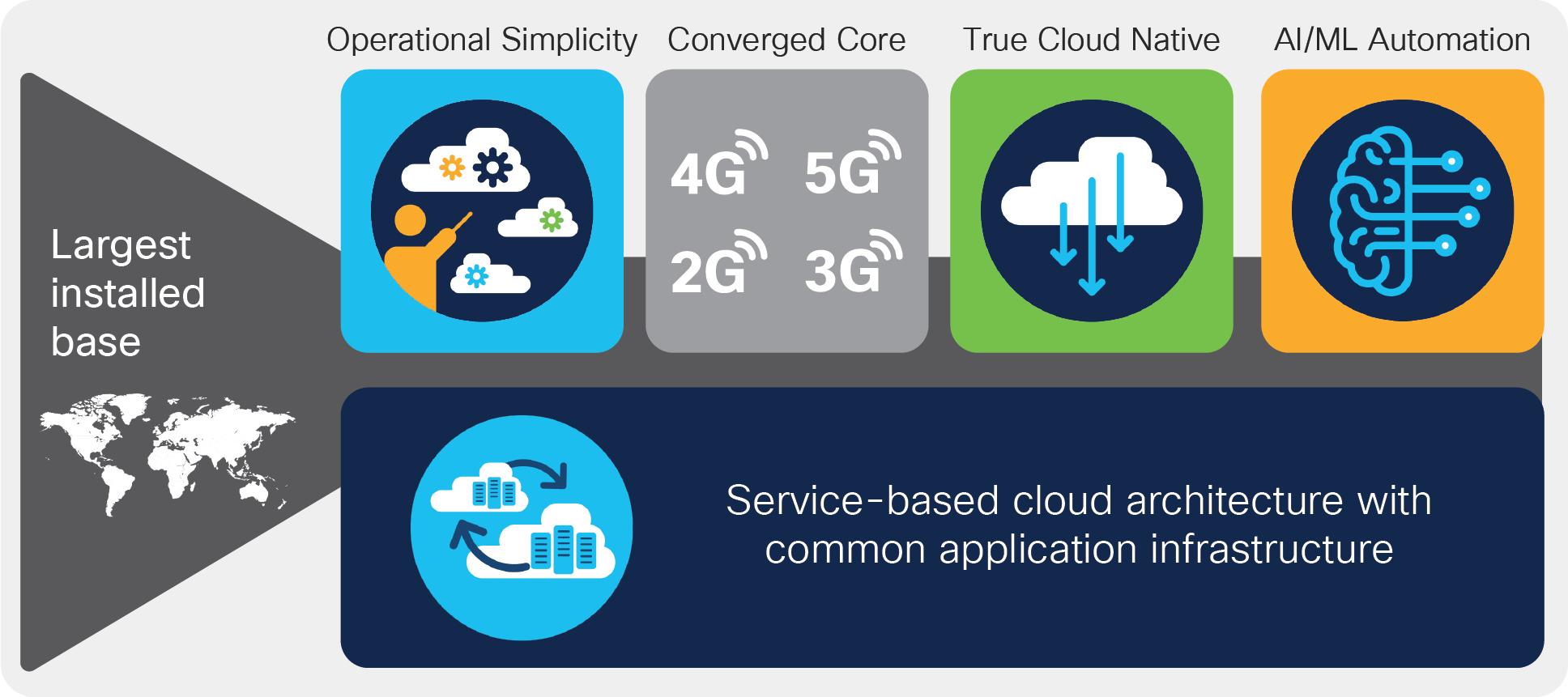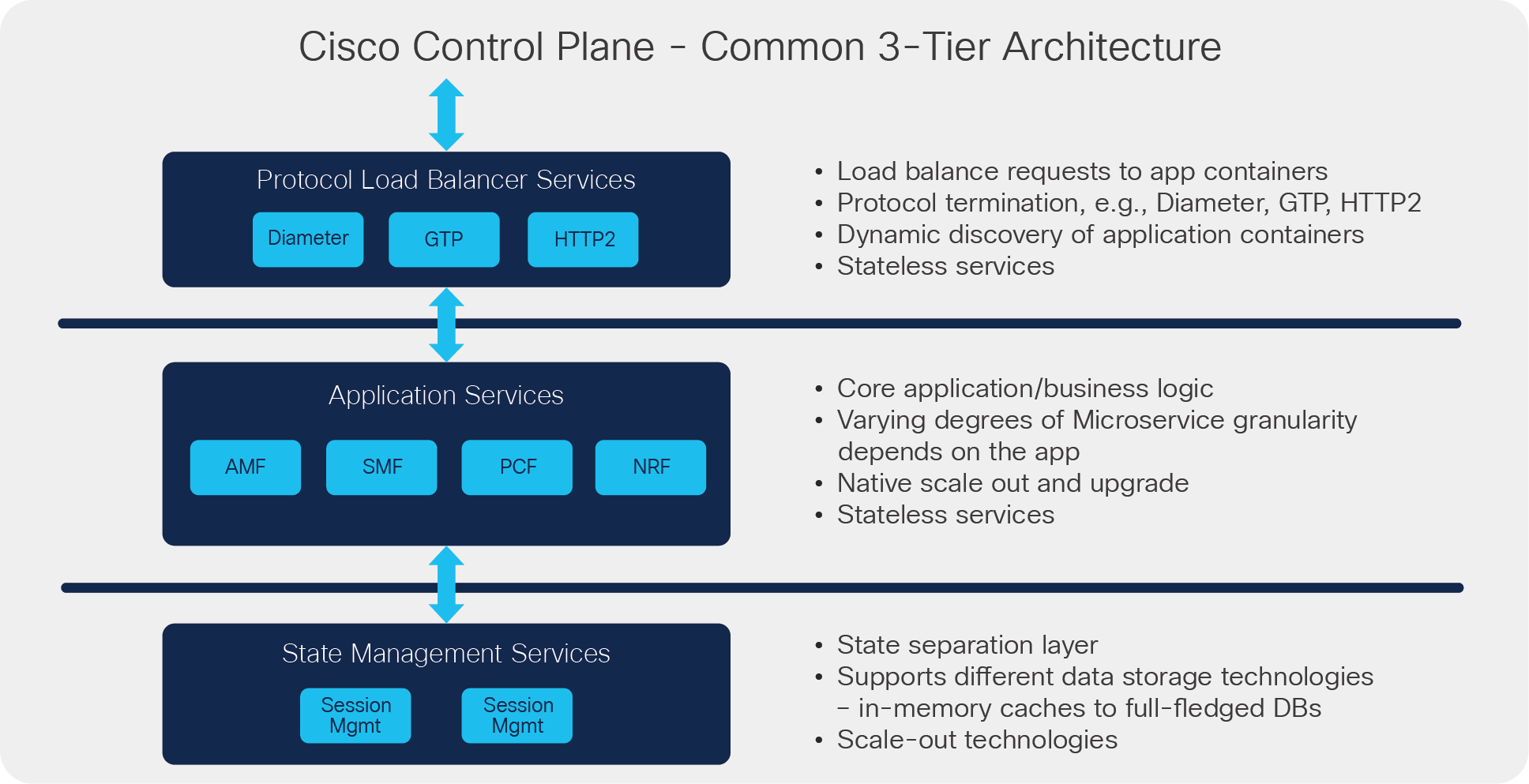Cisco 5G Policy Control Function (PCF) Data Sheet
Available Languages
Bias-Free Language
The documentation set for this product strives to use bias-free language. For the purposes of this documentation set, bias-free is defined as language that does not imply discrimination based on age, disability, gender, racial identity, ethnic identity, sexual orientation, socioeconomic status, and intersectionality. Exceptions may be present in the documentation due to language that is hardcoded in the user interfaces of the product software, language used based on RFP documentation, or language that is used by a referenced third-party product. Learn more about how Cisco is using Inclusive Language.
Cisco® Policy Control Function (PCF) is a cloud-native, converged policy function built on Cisco’s Subscriber Microservices Infrastructure (SMI). Cisco PCF allows service providers to control and monetize their networks while enabling new business models with operational simplicity and faster time to market.
The Cisco Policy Control Function (PCF) is one of the control plane Network Functions (NF) of the 5G core network (5GC). As we introduce 5G services, the policy solution is evolving to provide a harmonized PCF system, operating on a common cloud-native platform, with introduction of the new service-based interfaces required for the 5G SA Core.
The cloud-native PCF delivers on operational simplicity, reducing costs and time to market. It is also designed to deliver on customers outcome, by enabling new business and routes to market through flexible and fast service creation using service provider–configured business rules.

The 5G PCF has the following features and functions:
● Support 5G QoS policy and charging control functions and the related 5G signaling interfaces. The 3GPP standards, such as N7, N15, N28, N36, and Rx, define these interfaces for the 5G PCF.
● Provide policy rules for control plane functions, which include network slicing, roaming, and mobility management.
● Collect the subscriber metrics in context with their network, usage, applications, and more. The operators analyze this information to optimize resources and make informed decisions to segment users.
● Provide the real-time management of subscribers, applications, and network resources based on the business rules configured for a service provider.
● Accelerate and simplify deployment and upgrades using the ConfD CLI, increased speed and efficiency, and low latency by adopting the cloud-native implementation.
● Collaborate with other NFs through NRF, which provides a unified communication platform for the NFs to interact with each other.
| Feature |
Benefit |
| Subscriber Microservices Infrastructure (SMI) |
Enable rapid deployment of, and seamless lifecycle operations for, microservices-based applications. Support for network slicing, roaming, and mobility management. SMI is cloud native done better. |
| Policy Builder |
Allows the configuration of services and advanced policy rules. |
| Ops Center |
Provides a unified GUI for easier ability to configure Policy Builder, manage custom reference table data, and start the web-based applications and utilities. |
| Common Data Layer (CDL) |
CDL provides services for efficiently managing stateful subscriber sessions and identity information across all deployed Cisco NFs. The CDL is an in-memory database designed specifically for high-performance carrier-grade requirements. |
| Service Mesh |
The Service Mesh enabled through SMI connects and manages messages between all pods and services in the cluster. Using this service mesh, traffic is steered within the cluster to finely control which NF components are part of the traffic flow. |
| VoNR Through Rx Interface |
PCF supports the full Diameter stack along with the standard Diameter interfaces like Rx. With this support, you can configure PCF to handle VoLTE calls for 4G and VoNR for 5G. |
Advanced Policy Network Function for Mobility

● Integrated and synergistic portfolio of cloud-native 5G SA Network Functions (including SMI) and cloud-native Evolved Packet Core (EPC) functions, with select feature parity
● Cisco Service-Based Architecture –3GPP compliant and value adds
● Extensible and flexible cloud-native software product architecture
● Operational Efficiency/Automation – 3GPP and value adds
● Deployment Agility/CICD / ISSU
● Advanced 5G use cases via 3GPP and value-added solution architecture (transport, enterprise, automation)
● EPC/5Gcn Network Simplification via Cisco Mobility Common Core
● Open Network Architecture (3GPP, IETF, cloud/open source)
| Product Family |
Platforms Supported |
| 5G UCCPCF |
OSP, VMware, Cisco BM |
Cisco 5G Cisco Policy Control Function offers customers two licensing options.
1. Perpetual licensing model
2. Subscription licensing model
In both models, PCF software licenses are network-wide and based on number of sessions. For first-time procurement, there will be a one-time Base Software License, and network-wide Session Licenses will be provided. For any incremental capacity, licenses will be offered with additional session numbers in terms of PCF 1k sessions. Also, there is an option to enable Smart License in PCF function.
Smart Software Licensing
Smart Licensing is a cloud-based approach to licensing that simplifies the purchase, deployment, and management of Cisco software assets. Entitlements are purchased through your Cisco account via Cisco Commerce Workspace (CCW) and immediately deposited into your virtual account for usage. This eliminates the need to install license files on every device. Products that are smart enabled communicate directly to Cisco to report consumption. A single location is available to customers to manage Cisco software licenses – the Cisco Software Central (CSC). License ownership and consumption are readily available to help make better purchase decisions based on consumption or business need.
| Application |
Cisco Ultra Cloud Core 5G Policy Control Function (PCF) |
| Platform |
SMI-BM (UCS Bare metal CaaS Platform) |
| Host OS |
SMI Curated CSDL Compliant Ubuntu Host OS |
| Hardware Platform |
Ex: UCS-C220-M5 or higher |
The PCF is one of the control plane Network Functions (NFs) of the 5G core network. The PCF uses different interfaces to communicate with the other NFs or nodes – for example, the N7 interface exists between the SMF and PCF. Each of the PCF interfaces complies with a specific version of the 3GPP specification.
Table 1. Product 3GPP Interface Specifications
| Interface |
Relationship |
3GPP Specification |
| Rx |
Reference Point for Interworking with AF and PCF |
29.214 Release 15 & 16 |
| N7 |
Reference Point between SMF and PCF |
29.510 Release 15 & 16 |
| N15 |
Reference Point between AMF and PCF |
29.507 Release 15 & 16 |
| N36 |
Reference Point between UDR and PCF |
29.519 Release 15 & 16 |
| N28 |
Reference Point between PCF and CHF |
29.594 Release 15 & 16 |
| Lightweight Directory Access Protocol (LDAP) |
NA |
RFC 4511 (LDAP) |
| Nnrf |
Reference Point between PCF and NRF |
29.510 Release 15 & 16 |
Cisco PCF is a carrier-grade, high capacity, high-performance, containerized software solution capable of running on the Kubernetes environment. To meet the stringent performance, capacity, and availability demands, Cisco software requires that all allocated container resources be 100% available when needed, and not oversubscribed.
Individual NFs in Cisco Ultra Cloud Core software are deployed as K8s workers through Cisco Subscriber Microservice Infrastructure (SMI). Each NF has their own VM recommendations or host requirements based on Bare metal or Non-Bare metal deployment models.
Table 2. Software Container Specifications
| VM Purpose |
Redundancy |
# VMs |
vCPUs |
| SMI Cluster Manager |
NA |
1 |
2 |
| K8s Master |
3 |
3 |
2 |
| K8s Etcd |
3 |
3 |
2 |
| OAM |
3 |
3 |
12 |
| PCF Worker |
N+1 |
As per dimension |
As per dimension |
PCF Worker nodes that host the application pods will be calculated based on capacity required.
Similarly, for bare metal models, the number of physical hardware resources will be defined for the SMI-BM cluster and each Manager, K8s Master, Etcd, OAM, and Worker Nodes, as per dimensioning.
A typical hardware resource requirement is as follows:
Table 3. System Hardware Specifications
| CPU |
2 x 6148 CPU (20 cores @ 2.4GHz) |
| Memory |
384 Gb |
| Storage |
2 x 1.6 TB SSD RAID-1 |
| Host OS |
SMI-Curated CSDL-Compliant Ubuntu Host OS |
The Cisco Commerce Workspace is the primary tool used for ordering Cisco products and new services offered on the Cisco Price List. Cisco 5G Policy Control Function is available for ordering. To order, please visit, the Cisco Ordering Home Page or contact your Cisco account representative. To download software, visit the Cisco Software Central.
Table 4. Ordering Information for PCF Software:
| Part # |
Product Description |
| UCC-LIC-PAK-PS |
Ultra Cloud Core (UCC) 5G Perpetual SIA License Pack |
| UCC5G-PCF-BAS-L-K9 |
UCC - Policy Control Function (PCF), Base Minimum |
| UCC5G-PCF-S31-L |
Ultra Cloud Core (UCC) - Policy Control Function (PCF), 1K Sessions |
Table 5. Ordering Information for SMI Software:
| UCC-SMI-BAS-L-K9 |
UCC – Subscr Microsvcs Infrastruc (SMI) per cluster, Basic |
| UCC-SMI-PLS-L-K9 |
UCC – Subscr Microsvcs Infrastruc (SMI) per cluster, Plus |
| UCC-SMI-BML-L-K9 |
UCC – Subscr Microsvcs Infrastruc (SMI) per server, Bare metal |
Table 6. Similarly, we can order Subscription PIDs with Parent PID with desired duration:
| UCC-LIC-PAK-S |
Ultra Cloud Core (UCC) 5G Subscription License Pack |
Cisco PCF has the standard Cisco software warranty.
Using the Cisco lifecycle services approach, Cisco and our partners provide a broad portfolio of end-to-end services and support that can help increase your network’s business value and return on investment. This approach defines the minimum set of activities needed, by technology and by network complexity, to help you deploy and operate Cisco technologies and optimize their performance throughout the network lifecycle.
Flexible payment solutions to help you achieve your objectives
Cisco Capital® financing makes it easier to get the right technology to achieve your objectives, enable business transformation, and help you stay competitive. We can help you reduce total cost of ownership, conserve capital, and accelerate growth. In more than 100 countries, our flexible payment solutions can help you acquire hardware, software, services, and complementary third-party equipment in easy, predictable payments. Learn more.
Position your network for success with Cisco Policy Control Function (PCF). For more information, contact your local account representative.